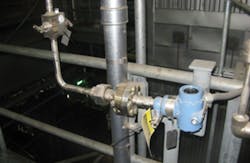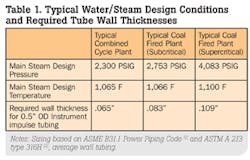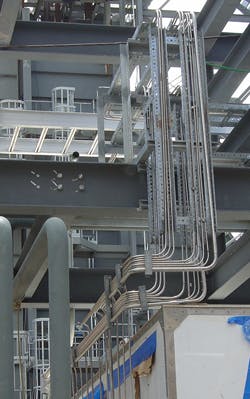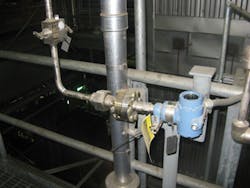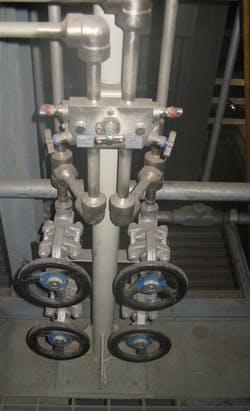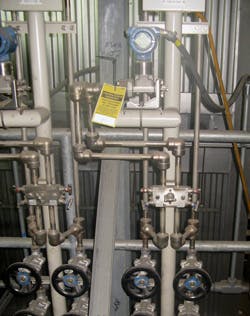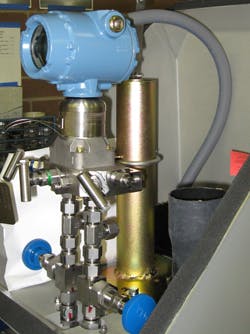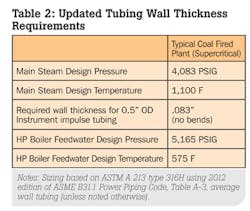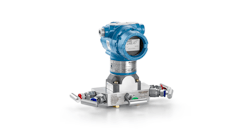Supercritical Instrument Installations
The recent generation of coal plants in the United States (and around the world) has seen a major increase in the use of supercritical technologies due to inherent efficiency advantages over subcritical designs. However, no gain is without cost in some form. Greater efficiency requires considerably higher pressures and temperatures, resulting in significant new challenges for critical system instrument impulse line design and installation.
In a supercritical plant, the pressures and temperatures for the main steam and feed water cycles routinely exceed that of conventionally fired drum-type boilers and combined cycle units. These elevated pressures and temperatures are particularly challenging for boiler manufacturers and engineers. Compliance with ASME B31.1 Power Piping requires much thicker piping and tubing walls, as well as stronger materials for valves and fittings.
For subcritical installations (which include both conventional coal units and combined cycle plants), instrument impulse lines have used tubing and mechanical grip-type fittings for many years with excellent reliability and operating experience. The old adage that the tube fitting will meet or exceed the rating of the tubing itself has been well established and documented. Similarly, tubing valves and manifolds were designed and certified for pressures and temperatures well in excess of those required for subcritical services. Selection of fittings, valves, and manifolds was easy and could be standardized on engineering specifications, details, and procedures.
Instrument installations for sub-critical steam impulse line applications are typically designed around the temperature of saturated liquid water. This is common practice for sensing lines associated with static pressure measurements or differential-pressure-based flow measurements. This is allowed by ASME code since the steam does not flow in the impulse line. Instead, the steam cools and condenses in the instrument line. Designing to saturation temperature for a sub-critical application translates to a design temperature no higher than 705 F. Temperatures can get higher during a blow-down of the instrument line. However, blow-down events are typically short-lasted and infrequent activities.
Supercritical steam, however, no longer follows the boiling model for material phase changes. The transition from water to steam does not include a distinct period (or set of conditions) where the water changes to steam. Instead, phase change is accomplished with very minor variance in pressure or temperature and no distinct transition phase from water to steam. For instrument impulse lines the result is a significantly higher fluid energy than for a saturated liquid. Correspondingly, the feed water pressure required to support supercritical steam production is also much higher than for subcritical services.
With the higher energy levels, the old adage about tubing, fittings and valves starts to break down. Tubing selection and design is no longer a “piece of cake”…
What Does the Code Specify?
Section 122.3.2 of ASME B31.1 [1] has several specific requirements for supercritical instrument piping and tubing.
- In general, tubing, piping, shutoff valves, and fittings must be rated for the same pressure and temperature of the process piping.
- Where blowdown valves are used, the blowdown valves, fittings and tubing around the instrument can either be rated for full design pressure and temperature, or for 1.5 times the piping design pressure at 100 F.
- For the piping/tubing from the root valve to the instrument tee, the ASME requirements dictate a rating of full design temperature and pressure.
- For steam services this translates to temperatures well above 1,000 F. For water services, this translates to pressures from approximately 4,500 PSIG up to 5,300 PSIG.
Compliance of a tube fitting, valve or manifold with ASME B31.1 can be tricky. There is no clear procedure that a vendor can obtain to certify products to B31.1. Some vendors attempt to assert compliance by burst testing. This is done by pressure testing components to the stated design pressure and temperature and then increasing the test pressure to the rupture of the tubing. However, this form of testing often fails to address all the requirements of B31.1, which, in addition to the above, mandate:
- Valve/fitting construction and end connections meet the requirements stated in the code. This includes references to valve body types, end connections (threaded, flanged, etc.), and other requirements depending on the service.
- The material of construction should be code-listed in Appendix A in conformance to the material chemical and physical properties (including ultimate and allowable strength) stated in that appendix.
- Where the material of construction is listed, but has higher strength properties than designated by B31.1, the allowable stress must be calculated based on the method prescribed (section 102.3.1 C, Allowable Stress Values and Other Stress Limits for Piping Components, and Boiler & Pressure Vessel Code, Section II, Part D, Mandatory Appendix 1) [3]. This calculated allowable stress must form the basis for the manufacturer’s pressure/temperature ratings.
Where the material of construction is not listed in the code, it must conform with the requirements of section 123.1.2, with special attention to the method used to calculate allowable stresses as defined previously.
The B31.1 allowable stresses are calculated based on a safety factor of approximately 28 percent of ultimate strength or 67 percent of yield strength at room temperature or operating temperature, whatever is most conservative. At elevated temperatures, the allowable stresses include additional factors to account for creep rupture. The bottom line is that merely burst testing the components is insufficient to establish B31.1 compliance as testing alone does not indicate what, if any, safety factor the manufacturer has used.
Other Factors that Complicate the Picture
Typical testing regiments don’t always address creep properties—especially at elevated temperatures. This is the area where cyclical loading at elevated temperature causes both permanent deformation of the material, as well as reductions in the allowable stress over time. Establishing creep properties can be difficult and expensive since it requires loading and unloading specimens repeatedly for millions of cycles at elevated temperatures.
There has been some debate on how pressure ratings are determined using the B31.1 allowable stress tables. There has not always been agreement between the designers and the equipment suppliers on which allowable stress ratings apply. Arguments over the required percent carbon content, allowable deflection/distortion, and other issues had to be resolved.
For example, there are two allowable stress values listed for B31.1. One value is significantly higher (meaning thinner walls would be allowed), but states that it allows for some actual deflection of the material when subjected to the stress limit. Factors like these had to be addressed through a more in-depth investigation of the stress tables, analysis of the fitting construction, and a consensus between designers and manufacturers.
Another aspect deals with threaded fittings. B31.1 section 122.3.6 [1] specifies that threaded fittings cannot be used for pressures over 5,000 PSIG. This means that for supercritical water over 5,000 PSIG (often associated with the ultra-supercritical designation), threaded joints cannot be used, even at the transmitter connection to the impulse tubing. In these services, welded or flanged joints at the transmitter are mandatory.
The Issues
With supercritical services, it turns out there were many concerns over whether or not a tube fitting would meet the pressure and temperature requirements, what valves or manifolds were available, what the required allowable stress would be, and others. The old adage was not necessarily true anymore.
All these factors in combination led many to dismiss tubing as a viable impulse line solution for supercritical applications. The maximum required wall thickness for 0.5-inch tubing approached 0.109-inch, compared to 0.083-inch for a subcritical plant. The typical tube fittings were either not rated for the high wall thickness or were not rated for the continuous high temperature service. There were some isolated cases where a specific site’s pressures and temperatures allowed the use of tubing. However, there were no consistent design practices that could be applied universally. The result was that many resorted to the expensive and time-consuming option of welded piping instead of tubing.
However, even the welded piping installation didn’t solve the problems completely. There were problems valve manifold failures, misapplication of welded adapters, improper sizing of welded joint connections, etc. The block and blowdown valves had to be full-pressure globe valves as opposed to tubing valves. This was all on top of the headaches of just routing and hanging schedule 160 stainless steel pipe with welded fittings.
A means was definitely needed to get back to tubing—but would it fall back to the same adage as before?
Fast Forward a Few Years…
As project teams struggled with the design, construction, and commissioning of impulse lines on instrumentation, the manufacturers began making strides to address the problems, and the codes progressed as well.
The manufacturers worked to develop solutions with varied approaches. In one case, a different class of tube fitting was upgraded and tested for use in supercritical services. The fitting series had previously been applied to elevated pressure services at moderate temperatures, typical of high-pressure wellhead applications in oil or gas service. Meanwhile, a valve product line suitable for supercritical services emerged. Both the fittings and valves used a modified version of the dual-ferrule grip-type fitting previously used. These fittings are compatible with heavy wall tubing (thicker than 0.083 inch), but the fitting assembly and installation is more difficult, requiring pre-swaging of the tubing, as well as a torque wrench to ensure proper tightness.
In another case, a supplier up-rated its existing fitting line to be compatible with higher temperatures (above 1,000 F). This was done with a new stainless steel material designation along with extra testing and certification. The same material can be used on valves for supercritical applications.
Manifolds continue to be a struggle as most manufacturers do not offer a manifold compatible with supercritical pressures and temperatures. This means that the blocking, test, and equalization functions must be implemented using separate valves. To date, few supercritical manifolds are available—those that are tend to be special order and may not include the hydrostatic testing required by B31.1
Concurrently with all this, the allowable stresses listed in ASME B31.1 have been increased over the last several years, mostly to bring the values more in line with other ASME piping codes. As shown in Table 1, prior to the revisions, the required wall thickness for 0.5 inch OD tubing on steam service exceeded 0.083 inch. For high-pressure feedwater, the required thickness could even exceed 0.109 inch.
However, the revisions to the allowable stress tables in B31.1, as well as a re-evaluation of which table values were appropriate, have reduced required wall thicknesses. The re-evaluation allows the use of the higher values that are associated with a design closer to the yield point. But the major fitting manufacturers, as well as plant designers have agreed that the dual ferrule fitting design is suitable for operation at those levels since the typical dual ferrule design tolerates small displacements associated with the higher stress levels.
The result is that 0.083-inch and 0.095-inch wall (depending on the service) is suitable for most supercritical applications when using 316H grade materials. There are some cases where the bending allowance must be omitted. This means that directional changes must use fittings instead of bends to the tubing. However this is a fairly minor compromise when compared to the use of pipe.
Summing It Up
With some attention to detail, tubing and grip-type fittings are now suitable for supercritical instrument services. The product offering may be a bit different depending on the supplier. Appropriate manifolds remain hard to find. However, the product lines now conform to the old adage of the fitting being stronger than the tubing.
As with any tubing or piping design, project-specific tube wall thickness calculations are recommended for the most severe services to verify proper rating. This includes instrument tubing for services such as high-pressure feedwater, boiler steam separator/separator drain tank, boiler outlet, and main steam. Calculations should also be run for hot-reheat tubing. Fittings generally meet or exceed the rating of the tubing. However, there may be some differences depending on fitting construction. Forged fittings may have different ratings when compared to machined fittings. This should be accommodated in the design to ensure that the fittings meet all pressure conditions.
The selected fitting valve series needs to be checked to verify they are properly rated prior to issuing any drawings or details.
If sizing tubing based on the manufacturer’s tubing rating tables, be sure to use the appropriate de-rating chart factors for elevated temperature. The factors are likely different from those used in non-supercritical applications.
When working with a new manufacturer, it is important to verify that the selected fittings and valves are indeed rated for the required conditions. It is also helpful to request certified material test reports to verify proper material chemistry. The suppliers also have reports available to document fitting performance in accordance with standards such as ASTM F1387 [4].
Allan G. Gilson, P.E., is the Instrumentation and Control Section Head for Black & Veatch Energy, headquartered in Overland Park, Kan. He provides process management and consulting for Instrumentation and Control engineering practices for a variety of energy and oil/gas projects. He is a member of ISA and ASME and currently serves on the PTC 19.3 Temperature Measurement committee. He has authored and co-authored a number of presentations and technical articles on thermowells, process tubing, and other subjects, including “The New ASME Thermowell Standard and Optimal Thermowell Design,” 2011. He can be reached at [email protected].
References
- Power Piping; ASME B31.1-2012; American Society of Mechanical Engineers, 2012.
- Standard Specification for Seamless Ferritic and Austenitic Alloy-Steel Boiler, Superheater, and Heat-Exchanger Tubes; ASTM A213/A 213M-11A; American Society for Testing and Materials, 2011.
- 2010 Boiler and Pressure Vessel Code. Section II, Part D, Mandatory Appendix 1; American Society of Mechanical Engineers, 2010.
- Standard Specification for Performance of Piping and Tubing Mechanically Attached Fittings. ASTM F1387-99; American Society for Testing and Materials, 2005.
